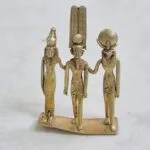The Book of Kells is considered one of the finest surviving medieval illuminated manuscripts.
Headlines
The Book of Kells: A Timeless Masterpiece Crafted by Monks Fleeing Viking Wrath

The Book of Kells is an awe-inspiring artifact from the past — a 1,200-year-old illuminated manuscript that contains the four Christian gospels, written in Latin. Created around the ninth century, this stunning work was crafted by Celtic Christian monks on the island of Iona, located in Scotland’s Inner Hebrides. The manuscript is a true masterpiece, adorned with intricate illustrations and intricate calligraphy, made even more remarkable by the fact that it predates the invention of the printing press.
What makes the Book of Kells particularly extraordinary is its vivid use of color and decoration. The pages are beautifully illuminated with paints made from gold, silver, and vibrant pigments, bringing the text to life in a way that was far ahead of its time. These illustrations not only enhance the reading experience but also serve as a window into the religious and artistic culture of the early medieval period.
The Book of Kells is not just a religious text; it is a testament to the skill, devotion, and creativity of the monks who produced it under challenging circumstances. The island of Iona, where the manuscript was likely created, was a place of refuge for these monks fleeing the Viking invasions that ravaged the British Isles during that era. Amidst the turmoil, they dedicated themselves to preserving and sharing the Christian faith through this extraordinary work.
Today, the Book of Kells offers invaluable insights into the history of Christianity, art, and manuscript-making. It stands as a symbol of resilience and artistic brilliance, a link between ancient religious traditions and the enduring legacy of craftsmanship.

image from wikipedia.org
The Book of Kells is a testament to the painstaking effort that went into creating books during the early medieval period. At a time when books had to be laboriously copied by hand, teams of monks often took on this monumental task. Experts believe the Book of Kells was created on the island of Iona around A.D. 800, crafted by monks who were dedicated to the mission of St. Columba, the Irish missionary who spread Christianity throughout Scotland.
However, the peaceful work of these monks was threatened by Viking raids that plagued the British coastline during this era. Many monks had already been killed in violent attacks on isolated communities like Iona and Lindisfarne. In response, the monks on Iona fled to Ireland in the early 800s, taking the precious manuscript with them. It was eventually housed in a monastery in Kells, Ireland, from which it got its name. But the Book of Kells‘s journey did not end there. During Oliver Cromwell’s conquest of Ireland in the mid-17th century, the manuscript was moved to Dublin for safekeeping. In 1661, it was donated to Trinity College Dublin, where it is still preserved and on display today.
The Book of Kells is widely regarded as the finest example of the “Insular” style of illuminated manuscripts, a tradition of artistic and scholarly work that flourished in Ireland and Britain after the fall of Rome. These manuscripts are famous for their intricate, decorative elements, including elaborate initial letters and whimsical designs featuring legendary creatures and Celtic motifs.
Written on vellum—calfskin that has been carefully scraped and prepared—the manuscript spans 680 pages, likely crafted by at least three different monks. Though some pages are missing, possibly due to a theft in the 11th century, the Book of Kells remains remarkably well-preserved for its age, offering an enduring glimpse into the past and the extraordinary devotion of the monks who created it.






